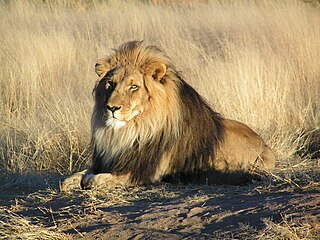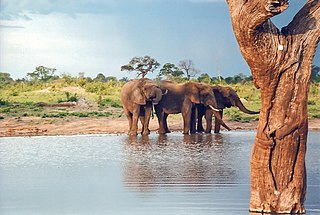
Maasai Mara, also sometimes spelled Masai Mara and locally known simply as The Mara, is a large national game reserve in Narok, Kenya, contiguous with the Serengeti National Park in Tanzania. It is named in honor of the Maasai people, the ancestral inhabitants of the area, who migrated to the area from the Nile Basin. Their description of the area when looked at from afar: "Mara" means "spotted" in the local Maasai language, due to the many short bushy trees which dot the landscape.

The lion is a large cat of the genus Panthera native to Africa and India. It has a muscular, deep-chested body, short, rounded head, round ears, and a hairy tuft at the end of its tail. It is sexually dimorphic; adult male lions are larger than females and have a prominent mane. It is a social species, forming groups called prides. A lion's pride consists of a few adult males, related females, and cubs. Groups of female lions usually hunt together, preying mostly on large ungulates. The lion is an apex and keystone predator; although some lions scavenge when opportunities occur and have been known to hunt humans, the species typically does not.

The leopard is one of the five extant species in the genus Panthera, a member of the cat family, Felidae. It occurs in a wide range in sub-Saharan Africa, in some parts of Western and Central Asia, Southern Russia, and on the Indian subcontinent to Southeast and East Asia. It is listed as Vulnerable on the IUCN Red List because leopard populations are threatened by habitat loss and fragmentation, and are declining in large parts of the global range. The leopard is considered locally extinct in Hong Kong, Singapore, South Korea, Jordan, Morocco, Togo, the United Arab Emirates, Uzbekistan, Lebanon, Mauritania, Kuwait, Syria, Libya, Tunisia and most likely in North Korea, Gambia, Laos, Lesotho, Tajikistan, Vietnam and Israel. Contemporary records suggest that the leopard occurs in only 25% of its historical global range.

The cheetah is a large cat native to Africa and central Iran. It is the fastest land animal, estimated to be capable of running at 80 to 128 km/h with the fastest reliably recorded speeds being 93 and 98 km/h, and as such has several adaptations for speed, including a light build, long thin legs and a long tail. It typically reaches 67–94 cm (26–37 in) at the shoulder, and the head-and-body length is between 1.1 and 1.5 m. Adults weigh between 21 and 72 kg. Its head is small and rounded, and has a short snout and black tear-like facial streaks. The coat is typically tawny to creamy white or pale buff and is mostly covered with evenly spaced, solid black spots. Four subspecies are recognised.
The term "big cat" is typically used to refer to any of the five living members of the genus Panthera, namely the tiger, lion, jaguar, leopard, and snow leopard, as well as the non-pantherine cheetah and cougar. However, only the first 4 of these species are able to roar.

The Houston Zoo is a 55-acre (22 ha) zoological park located within Hermann Park in Houston, Texas, United States. The zoo houses over 6,000 animals from more than 600 species. It receives 2.1 million visitors each year and is the second most visited zoo in the United States. It is accredited by the Association of Zoos and Aquariums (AZA).

Hwange National Park is the largest natural reserve in Zimbabwe. It is around 14,600 sq km in area. It lies in the northwest of the country, just off the main road between Bulawayo and Victoria Falls. The nearest town is Dete. Histories of the region's pre-colonial days and its development as a game reserve and National Park are available online

Trophy hunting is hunting of wild animals as trophies, with the whole or parts of the hunted animal kept and usually displayed to represent the success of the hunter. The preferred target animal, known as the game, is typically a large or impressively ornamented male, such as one having large horns or antlers. Usually, only some parts of the animal are kept as trophies, although preserving the entire animal via taxidermy is also practised.

The African leopard is the nominate subspecies of the leopard, native to many countries in Africa. It is widely distributed in most of sub-Saharan Africa, but the historical range has been fragmented in the course of habitat conversion. Leopards have also been recorded in North Africa as well.

Jonathan Scott is an English zoologist, wildlife photographer and television presenter specializing in African wildlife.

The Zanzibar leopard is an African leopard population on Unguja Island in the Zanzibar archipelago, Tanzania, that is considered extirpated due to persecution by local hunters and loss of habitat. It was the island's largest terrestrial carnivore and apex predator. Increasing conflict between people and leopards in the 20th century led to the demonization of the Zanzibar leopard and determined attempts to exterminate it. Efforts to develop a leopard conservation program in the mid-1990s were shelved when wildlife researchers concluded that there was little prospect for the population's long-term survival. In 2018, a leopard was recorded by a camera trap, thus renewing hopes for the population's survival, although some experts remain skeptical.

Human–wildlife conflict(HWC) refers to the negative interactions between human and wild animals, with undesirable consequences both for people and their resources, on the one hand, and wildlife and their habitats on the other. HWC, caused by competition for natural resources between human and wildlife, influences human food security and the well-being of both humans and animals. In many regions, the number of these conflicts has increased in recent decades as a result of human population growth and the transformation of land use.
Felidae Conservation Fund (FCF) is a California-based non-profit organization dedicated to preserving wild cats and their habitats. The organization supports and promotes international wild cat research and conservation by collaborating on field research projects, partnering with other environmental organizations, and developing community outreach and education programs.

Panthera Corporation, or Panthera, is a charitable organization devoted to preserving big cats and their ecosystems around the globe. Founded in 2006, Panthera focuses its efforts on conservation of the world's largest, most imperiled cats: tigers, lions, jaguars and snow leopards, and also developing conservation programs for cheetahs, leopards and cougars. The organization has offices in New York City and London.
The Naankuse Foundation Wildlife Sanctuary, also stylized Nǀaʼankusê, is a wildlife sanctuary in central Namibia, situated c. 42 kilometres (26 mi) outside Windhoek. Besides the sanctuary the establishment also runs a carnivore conservation research programme, the Clever Cubs Pre-primary School, and a clinic for the San people. Naankuse is a Juǀ'hoan word that means "God will protect us", or "God watches over us." The sanctuary opened in 2007. It is run by Namibian conservationist Marlice van Vuuren and her husband Rudi van Vuuren. Naankuse is funded by voluntary donations and relies on the time of volunteers to continue its projects.

The protected areas of Namibia include its national parks and reserves. With the 2010 declaration of Dorob National Park, Namibia became the first and only country to have its entire coastline protected through a national parks network. Protected areas are subdivided into game reserves and/or nature reserves, such as special protected area, wilderness areas, natural areas, and development areas. There are also recreation reserves. Facilities in the national parks are operated by Namibia Wildlife Resorts. Over 19% of Namibia is protected, an area of some 130,000 square kilometres. However, the Ministry of Environment & Tourism auctions limited hunting rights within its protected areas. The Namibia Nature Foundation, an NGO, was established in 1987 to raise and administer funds for the conservation of wildlife and protected area management. Communal Wildlife Conservancies in Namibia help promote sustainable natural resource management by giving local communities rights to wildlife management and tourism.

The East African cheetah, is a cheetah population in East Africa. It lives in grasslands and savannas of Tanzania, Kenya, Uganda and Somalia. The cheetah inhabits mainly the Serengeti ecosystem, including Maasai Mara, and the Tsavo landscape.

The Southeast African cheetah is the nominate cheetah subspecies native to East and Southern Africa. The Southern African cheetah lives mainly in the lowland areas and deserts of the Kalahari, the savannahs of Okavango Delta, and the grasslands of the Transvaal region in South Africa. In Namibia, cheetahs are mostly found in farmlands.
Amelia Jane Dickman is Professor of Wildlife Conservation and Director of WildCRU at the University of Oxford, Kaplan Senior Research Fellow at Pembroke College, Oxford and joint CEO of Lion Landscapes. She is best known for her leadership of the Ruaha Carnivore Project, seeking to improve conservation outcomes for lions and other carnivores in the Ruaha National Park of Tanzania. She is known for her views on the importance of scientific and local community input into discussions around the continued importance of trophy hunting for the conservation of African landscapes.














